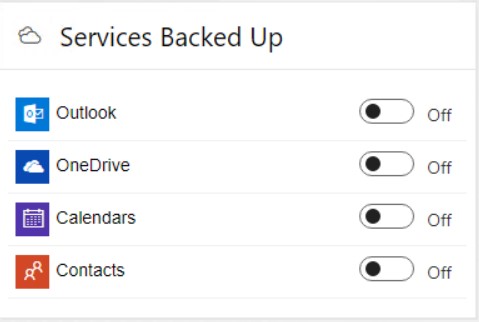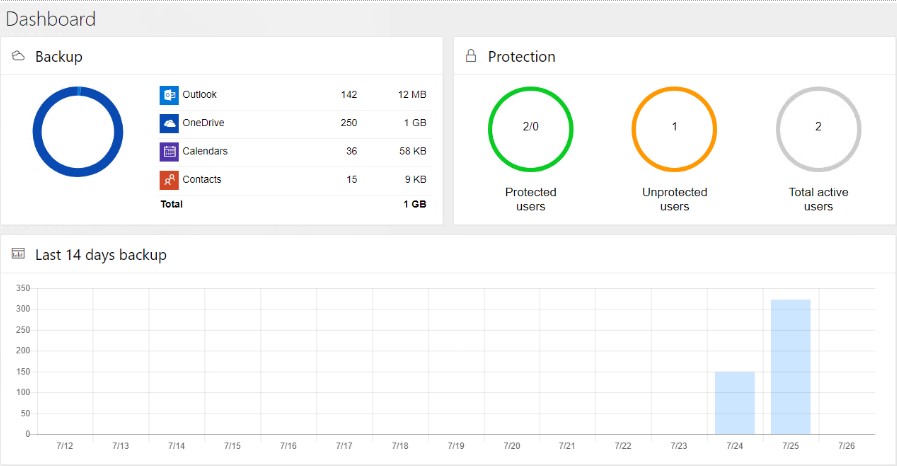Microsoft Office 365 Data Protection: The Cost of Data Loss
Let’s talk about Office 365 Data Protection. Data is at the very heart of today’s businesses, both large and small. In the past, the criticality of data was more of a concern for larger corporations. In today’s data-driven world, even small business revenue, including “mom and pop” operations and SMB markets are driven by data and technology.
Businesses are increasingly using technology to streamline operations. It helps to improve accuracy and reduce the number of employees needed to perform essential tasks. More and more businesses across the board are moving their data-centric operations to the public cloud. The public cloud has changed how businesses view IT infrastructure and data storage. It has shifted how data is processed and archived. This affects businesses of all sizes.
The cloud data revolution has presented challenges in terms of Office 365 data security, as traditional mechanisms for data protection are no longer relevant. Microsoft’s Office 365 public cloud solution has become a major player in the public cloud space with many businesses either migrating to Office 365 from on-premises environments or other public cloud vendors.
Let’s take a look at the topic – Office 365 Backup Why Important? In considering this topic we will look at why native mechanisms for data protection are simply not enough in Office 365 and the potential cost of ineffective data protection. How can businesses effectively solve these challenging Office 365 security concerns while still taking full advantage of the public cloud?
Why Businesses are Moving to the Cloud
Before looking at why protecting data in the public cloud is important, let’s take a step back and see how the IT infrastructure and data landscape has changed so drastically in the past 5 years or so. Businesses today have experienced a data and technology revolution that has fueled the need to move as quickly and efficiently as possible. Quick and efficient movement of physical infrastructure is not common when obtaining, setting up, and using IT infrastructure on-premises.
Cloud technology has revolutionized IT infrastructure. Organizations can now treat IT infrastructure as an on-demand service. They can consume, provision, and utilize it as needed. The large public cloud vendors today, including Amazon, Microsoft, and Google, all have a multitude of services in their portfolio that businesses can generally find that fit any use case they may have for infrastructure or services.
When initially migrating to public cloud environments, there are generally two primary business services that organizations typically choose to shift to the public cloud before others. These two services are email and file storage. Email services have been the core of business communication for decades now.
With Microsoft’s Office 365, organizations can effectively start shifting email services from on-premises to Office 365 and choose to house email either natively with Office 365 or in a hybrid solution where mailboxes exist in both the public cloud environment and on-premises in Exchange.
Office 365 also provides file storage services in the form of OneDrive for Business. OneDrive provides an effective storage location that allows organizations to access files, folders, and data anywhere. Microsoft has provided excellent integration from their Office 365 suite to allow accessing storage resources located in OneDrive storage.
Without a lot of infrastructure or configuration changes, both the Office 365 email and OneDrive for Business options allow organizations to shift resources easily to the public cloud. However, there is a very important consideration that comes with the ease at which this can be accomplished – data protection.
Most businesses have a solution for protecting their data that exists on-premises. Protecting data in the public cloud, including Microsoft’s Office 365 environment, is an important consideration. Few organizations have planned for this or have the tools to do it effectively.
A perfect storm of potential data loss can result when improper tooling is coupled with gross misconceptions of how data is protected once it is stored in the cloud. Microsoft and other vendors have world-class infrastructure and data centers on which Office 365 runs. However, there are few built-in mechanisms to retrieve data in the way that businesses are used to on-premises. Let’s see why the built-in data recovery mechanisms are just not enough.
Native Cloud Office 365 Data Protection is Lacking
An area that is sorely lacking in the native functionality of public cloud environments is data protection. The major public cloud vendors and their infrastructure are extraordinarily resilient. They have data center uptime ratings across the board that private organizations could only dream of having. This means that you can rest easier at night with any outage that might result from a high availability problem such as a site going down, an Internet service provider’s circuit going down, or some other service interruption due to facilities issues.
A common misconception concerning public cloud infrastructure is they provide some “magical” protection for your data, making it immune to any loss. This is simply not true. Your data in the public cloud is your responsibility to protect. While there are certain SLAs attached to data and services provided by public cloud vendors, at the end of the day, if you suffer an outage due to data loss, they are not responsible.
There are many other important considerations that need to make when it comes to your data and events that can lead to data loss. What are those? When thinking about data loss or events that can disrupt business continuity, often it is an event that is a result of user actions, such as accidentally deleting data. Other events including ransomware can wreak havoc on environments that have a presence in the public cloud.
Ransomware is an especially dangerous risk to business-critical data. Ransomware slyly and silently encrypts organization data without warning. This results in data that is corrupted and unreadable without the encryption key, provided only if the victim pays the ransom to the attacker.
You might wonder how ransomware infects files that are found in the public cloud. A significant threat vector to files stored in the public cloud is file synchronization. While file synchronization is used to keep data in sync, it can inadvertently synchronize encrypted/corrupted files to the public cloud without the end-user noticing. The encrypted files synchronized to the cloud are simply treated as newer versions of the files that may be unencrypted and healthy.
Microsoft provides the OneDrive virtual drive that is built into the modern versions of Windows that provide this synchronization capability. It is readily accessible in the Windows operating system and is often utilized by businesses that are using OneDrive for business. The threat vector for synchronizing encrypted files to the cloud is very real. Businesses today must be on guard and have data protection in place to allow remediating these types of ransomware concerns.
Microsoft has made better strides as of late with helping to protect users from this type of data loss with OneDrive for business. Recently, Microsoft added functionality to allow users to restore files in OneDrive up to 30 days back. This can help businesses to have a quick and easy way to restore data that may have been accidentally deleted, or infected with ransomware. The Microsoft mechanism allows choosing a previous version of a file and then restoring the file back to the previous version.
If ransomware has infected OneDrive files or the files have been deleted, those files can be retrieved to a previous version using this built-in functionality. It needs to be noted that this functionality provided by Microsoft is very basic. Currently, the only service protected using this limited restore functionality is OneDrive. All other Office 365 services including Email, Contacts, Calendar, or SharePoint are not natively protected.
Relying solely on this built-in means for restoring or protecting data in Office 365 can leave businesses exposed to potential data loss, both in OneDrive and the other major Office 365 services. Businesses simply cannot rely on business-critical data or services that exist in Office 365 without having additional means for protecting data.
When considering the threat of ransomware, files located in OneDrive are not the only resource that may be at danger of being encrypted. It is perhaps lesser known that ransomware can also encrypt and infect email messages that are contained in Office 365 email as well. Email messages can be silently encrypted and opened only if the ransom is paid.
Again, Microsoft’s native mechanism at this point does not cover Office 365 email. So, organizations are on their own to provide data protection and recovery for their email services.
The Cost of Data Loss
Considering data loss and other consequences of not properly protecting data, the cost can be significant. For some organizations, the number of transactions or sales that could be disrupted due to data loss that takes services offline even for a few minutes could amount to millions of dollars.
There are other subtler costs to data loss however that are much more difficult to discern, but no less concerning. The remaining costs to data loss can be intangible costs that result from service interruptions that affect customers, their perception of service reliability, and their business reputation.
What are the costs of dissatisfied customers? What about the costs of a tarnished business reputation? These types of costs are often hard to calculate; however, they can be some of the costliest consequences to data loss events as they often linger well past the service interruption or the data loss event, even when services and data are restored.
This is especially true if businesses are unable to restore data as a result of a data loss event. If businesses are left with a situation where data is simply unrecoverable, the negative impact on business reputation can cost a business its livelihood to the point it is no longer able to stay in business.
Some businesses may mistakenly think they would never be the target of a cybersecurity attack or ransomware infection that would disrupt business operations. However, statistics show that cyberattacks and other ransomware events are on the rise. In looking back at 2021 by way of cybersecurity events so far, there has already been an alarming number of high-profile data breaches and data exposed by attackers looking to capitalize on ineffective data security and data protection.
In today’s technology and data-driven world, businesses must protect their own data. How can customers protect data that lives in Microsoft Office 365 environment? Spinbackup provides the single answer to a multitude of business problems that allow organizations to effectively protect their cloud-centric data. Let’s see how.
SpinOne’s Single Answer to Office 365 Data Protection
As mentioned, the native functionality that Microsoft provides is basic at best. In addition, the rudimentary recovery functionality only covers OneDrive for business. This is certainly not acceptable for businesses running their business-critical infrastructure from the Office 365 cloud. Business continuity may depend on aggressive RPO and RTO values for data and business services located in other Office 365 offerings that are not natively protected.
Many organizations may be able to piece together disparate services that are able to provide data protection to the various Office 365 services being utilized. Often, however, these additional third-party services providing data protection do not provide a consolidated management interface or other tight integration that allows businesses to have the control and visibility needed and the protection required.
Spinbackup provides a single solution that allows businesses today to provide data protection for their Office 365 environments and all services therein. Spinbackup offers world-class protection for businesses. It covers Email, Calendar, Contacts, Sharepoint, and OneDrive. The interface is easy to navigate and provides lots of features for administrators. They can gain granular control over the environment.
In addition to the data protection capabilities that Spinbackup provides, Spinbackup stands in a class of its own providing extremely powerful cybersecurity functionality within the Office 365 environment which allows businesses to provide protection that goes full circle. The cybersecurity functionality helps businesses to prevent the security events that often lead to data loss in the first place, and the data loss protection allows recovering data that may have been affected by any number of events.
Spinbackup is the only Office 365 data protection solution that provides organizations with the control they need over where backup data is housed. By allowing customers to choose the public cloud provider that will house the backend storage for Office 365 backups, businesses can make decisions based on company policies and provide a diversity of data. Just a few of the extremely important highlights of the solution Spinbackup provides include the following:
- Data Diversity – Organizations can choose to effectively house backup data in a different public cloud provider than the service is backed up. This allows the fullest measure of protection against having all data, both production and backup data in the same public cloud infrastructure.
- Automated Backups – Powerful automated backups either 1x or 3x daily allow organizations to have effective automated data protection that allows taking multiple snapshots each day of business-critical data.

Automated Office 365 daily backups using Spinbackup
- Granular Recovery – Restore either specific files or an entire user account worth of data. Depending on the amount of data loss, Spinbackup provides the ability to recover the data in a manner that fits the use case.
- Covers Email, Contacts, Calendars, OneDrive, and SharePoint – Rather than being partially covered by Microsoft’s native solution that only covers 30 days’ worth of data in OneDrive, Spinbackup provides infinite recovery points for all the major Microsoft Office 365 services.

Spinbackup provides protection for all major Office 365 services
- Cybersecurity features – Not only does Spinbackup provide the backup features organizations need for Office 365 environments, it also provides a powerful API-driven CASB that helps organizations provision a policy-driven infrastructure in Office 365 with machine learning-enabled intelligence.
- Threat detection – Cybersecurity should be proactive instead of reactive. The intelligence that Spinbackup provides in the realm of cybersecurity allows organizations to proactively monitor and act before security events compromise the integrity of Office 365 environments
- DLP and much more – Data Loss is extremely concerning, especially for public cloud environments. Keeping up with who has access to data and ensuring that data is not transmitted outside the Office 365 environment can be extremely challenging. Spinbackup DLP solutions take the challenge out of the environment by effectively monitoring and preventing data loss and data leaks outside the organization.

Spinbackup provides a streamlined, intelligent look at Office 365 data protection
Concluding Thoughts
Microsoft’s Office 365 environment provides businesses today with a powerful, feature-filled public cloud environment that allows organizations to have access to exciting infrastructure and services that may otherwise be unattainable. Many businesses today may start their migration to the public cloud by shifting email and file storage to the cloud. Office 365 provides a great platform for both email and file storage for organizations looking at migrating these types of business-critical services to the cloud.
While moving to the public cloud can present tremendous benefits to businesses today, it can also bring to light the challenge of protecting data that is stored there. Data is certainly the heart of businesses today, both large and small. Protecting that data is key for an organization’s survival in a world filled with cybersecurity and other threats. Traditional data protection solutions that businesses use for protecting data on-premises are either not effective or relevant in public cloud environments.
Organizations need a purpose-built, all-in-one solution that allows effectively protecting their Office 365 data and also provides protection against cybersecurity threats. Spinbackup is the single solution that answers all the tough business questions surrounding data protection and cybersecurity in Office 365. Spinbackup offers a range of data storage solutions. Automated backups and machine learning-enabled cybersecurity protection ensure businesses can feel secure in the Office 365 public cloud. As a result, businesses can “sleep well at night” knowing their data is safe.
Frequently Asked Questions
How does Microsoft 365 protect data?
Microsoft 365 data protection features vary depending on the subscription plan, but in general, these include:
- antiphishing, antispam, and antimalware protection;
- multi-factor authentication (MFA);
- data encryption at rest and in transit;
- data backups and restoring;
- ransomware detection and recovery;
- protected environment for communicating and sharing files with Microsoft Teams, OneDrive, and SharePoint.
Is Office 365 data encrypted?
Yes, Office 365 has data encryption features. It uses several encryption protocols that include Transport Layer Security/Secure Sockets Layer (TLS/SSL), Internet Protocol Security (IPSec), and Advanced Encryption Standard (AES).
What are the security risks of Office 365?
Typical security risks related to Office 365 include unauthorized access, data loss, insider threats, phishing, malware and ransomware, compliance, mobile device security, lack of awareness and training programs, insufficient patch management, and configuration errors
Was this helpful?
How Can You Maximize SaaS Security Benefits?
Let's get started with a live demo
Latest blog posts
Brewing Trouble: How a Starbucks Ransomware Attack Poured Cold Wate...
Cybercriminals often carry out attacks around holidays as this helps to ensure the most amount...
Data Loss Prevention Techniques for 2025 and Beyond
It’s painstakingly clear that data loss is a major challenge facing businesses today. Our experts...
What is SaaS Security? Challenges & Best Practices
Businesses increasingly rely on Software as a Service (SaaS) for increased efficiency, collaborativeness, and scalability....


